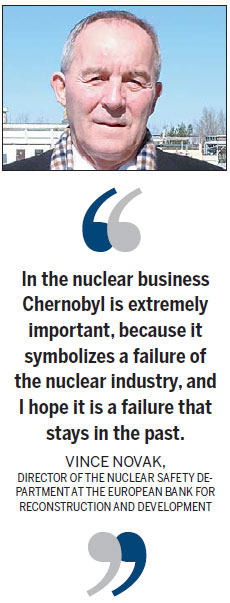Restoring faith in nuclear power
Updated: 2015-03-20 07:37
By Cecily Liu(China Daily Europe)
|
|||||||||||
China contributes to safety enhancement work through cooperation and technology
The European Bank for Reconstruction and Development has recognized China's contribution toward the nuclear safety enhancement work required at Chernobyl nuclear power plant and expressed hope for China's further cooperation.
Although China was an emerging country in 1986, when the Chernobyl crisis occurred, its subsequent economic growth and nuclear industry development has led it to participate in international efforts to assist Chernobyl's transformation work.
|
The New Safe Confinement's construction will be completed in 2017 to help reduce risks of radiological exposure from the damaged reactor. Photos by Cecily Liu / China Daily |
In 2011, China contributed 4 million euros ($5.9 million) to the Chernobyl Shelter Fund, which was established at the EBRD in 1997. Currently, 26 countries have contributed toward the fund, and the fund has disbursed 1.4 billion euros as of the end of 2014.
"I know that China responded to the invitation of the G7 leaders and the European Union, and China came to the pledging conference in Kiev in 2011," says Vince Novak, director of the nuclear safety department at EBRD.
Novak says that as China continues to grow and develop its nuclear industry, he hopes China can further participate in the CSF to enhance nuclear safety work in cooperation with the international community.
Novak was speaking during a press tour of the Chernobyl power plant, which showed the progress already made in the construction of the New Safe Confinement, a structure that will be completed in 2017, to help reduce risks of radiological exposure of the damaged reactor.
Despite being very close to the New Safe Confinement's construction completion, the Shelter Implementation Plan is still experiencing a shortfall of 615 million euros in funding, EBRD will host a donor's conference in London on April 29 in an attempt to close the funding gap.
The EBRD has already decided to commit an additional 350 million euros from the bank's reserves and there is an anticipated 165 million euros contribution from the G7 countries and the European Commission, leaving a shortfall of 100 million euros required from additional donors.

Novak says that the completion of the New Safe Confinement will be crucial in improving public perception of nuclear power, adding that he is confident it will be finished on schedule and on budget.
"In the nuclear business Chernobyl is extremely important, because it symbolizes a failure of the nuclear industry, and I hope it is a failure that stays in the past. But until Chernobyl has been put behind us, the credibility of nuclear power is at stake," he says.
The Chernobyl nuclear disaster that took place on 26 April 1986, caused deaths, within weeks, of some 30 workers and firemen at the plant, and injured many others. Its long-term impact on the health of others is the subject of debate to this day.
The disaster also led to the evacuation of about 200,000 people from regions neighboring the destroyed reactor, and caused long term economic damage to the area. A 30 kilometer closed exclusion zone was imposed, which is still in place.
In the weeks after the accident, a large amount of fuel containing material was dropped from helicopters to contain the radioactive material in the damaged reactor, confined by a hastily constructed concrete sarcophagus.
As this sarcophagus could still pose risks, the New Safe Confinement was constructed and will be moved into position over the sarcophagus in 2017.
It will protect the environment from radiation releases and provide the infrastructure to support deconstruction of the sarcophagus and nuclear waste management operation over its 100-year design life.
The New Safe Confinement is a huge lattice construction of tubular steel built on two longitudinal concrete beams. In order to reduce radiological exposure to the workforce, the arch has been assembled 250 meters to the west of the damaged reactor and will later be moved over the shelter.
The construction work is now focusing on the installation of a sophisticated ventilation system that will keep the structure corrosion-free during its lifespan and the technological building that will house control and electrical systems and equipment for decontamination.
Aside from CSF, EBRD manages another donor fund that finances the decommissioning infrastructure and related works in Chernobyl, known as the Nuclear Safety Account. Established in 1993, the NSA today finances two important projects in Chernobyl, which are the Interim Spent Fuel Storage Facility and the Liquid Radioactive Waste Treatment Plant.
ISF2 will provide safe and secure storage of the spent nuclear fuel that was generated when the plant was operational. It is currently in the final phase of construction, and will process, dry and cut more than 20,000 fuel assemblies and place them in metal casks.
LRTP retrieves highly active liquids from their current tanks, processes them into a solid state and moves them to containers for long-term storage. The plant has been completed and received its operating license in December 2014.
Novak says that the task of managing the two donor funds prompts EBRD to take on a very different role from its day-to-day operation, which is to provide loans in the expectation of generating returns. Instead, the EBRD is providing a service to the international community, and has also become the largest contributor to the NSC and ISF2 projects, with total commitments from its own resources of 675 million euros.
"It started in 1992, when the top priority of the international community was to address the issue of nuclear safety associated with the first generation Soviet designed reactors. That was the first time the international community approached EBRD, and that was the beginning of the nuclear safety team at the bank," Novak says.
Over the years, Novak says he has experienced both excitement and frustration while leading the nuclear safety team, and is very proud to witness all its progress today.
"This has been an extremely difficult program. In the beginning no one knew what needed to be done because the roadmap was on a conceptual level and we had to develop the solutions, and verify them through preliminary engineering.
"But the transformation of the site we witnessed was phenomenal and I have seen it appears very realistic that we will succeed in completing this New Safe Confinement by 2017," he says.
Novak says that he believes nuclear is an important energy option for the future, as it ensures sufficiency of energy but at the same time protects the environment from the pollution that inevitably comes from the burning of fossil fuel.
He also praised China's nuclear industry strength. "China is a global power, which has the largest nuclear program in the world. I believe it will become not only the recipient of nuclear technology but an active exporter of technology," he says.
China currently has 22 nuclear power reactors in operation with an installed capacity of about 17 gW. A further 26 units are under construction, with combined capacity totaling almost 30 gW.
In November, the State Council rolled out an energy plan to have more efficient, self-sufficient, green and innovative energy production and consumption. The plan envisages having 58 gW of nuclear power in operation by 2020 and at least 30 gW under construction.
The Chinese nuclear industry's international focus began in 2005 when the National Development and Reform Commission, the country's top economic planner, suggested selling the country's nuclear expertise overseas. China has so far built overseas reactors only in Pakistan.
But one high profile nuclear program that could allow China to establish a solid reputation internationally is the UK's Hinkley Point C project. Led by EDF Group of France, the two planned reactors will cost 14 billion pounds ($18.4 billion), and are due to start operating in 2023 if built on time and will run for 35 years.
Majority-controlled by EDF, China General Nuclear Power Group and China National Nuclear Corporation are expected to have a combined 30 to 40 percent stake in the consortium, with Areva taking the remaining 10 percent. Further commercial cooperation details of the investment are expected to be announced soon.
As part of the agreement, EDF will in turn support the two Chinese nuclear companies in a further UK nuclear project, which will be majority owned by the Chinese investors and use a significant amount of Chinese nuclear technology.
In December, China's own nuclear technology, the ACP1000 technology developed by China National Nuclear Corp, passed the Generic Reactor Safety Review by the International Atomic Energy Agency, a milestone that puts China on a level playing field to compete against the West in bidding for international projects.
The ACP1000 forms the core technology of the Hualong One, a third-generation nuclear reactor design jointly developed by the CNNC and the China General Nuclear Power Group. Hualong One was created earlier this year in a government initiative to form a coherent nuclear technology policy in China.
The development of third-generation nuclear technology came about after the Fukushima nuclear power station disaster in Japan, and has been designed to ensure better safety. China, the United States, France and Russia all have their own third-generation nuclear technology.
cecily.liu@chinadaily.com.cn
(China Daily European Weekly 03/20/2015 page14)
Today's Top News
Russia, China to uphold WWII history
Sanctions linked to Minsk deal implementation: EU
Australia to invest A$3b in AIIB
Germany insists Greece must stick to bailout agreement
Manhunt launched for accomplices in Tunisian museum attack
Chanel to reduce prices in China
Russian FM slams Kiev for turning Minsk agreements 'upside down'
European chamber calls on China to boost reforms
Hot Topics
Lunar probe , China growth forecasts, Emission rules get tougher, China seen through 'colored lens', International board,
Editor's Picks

|

|

|

|

|

|






